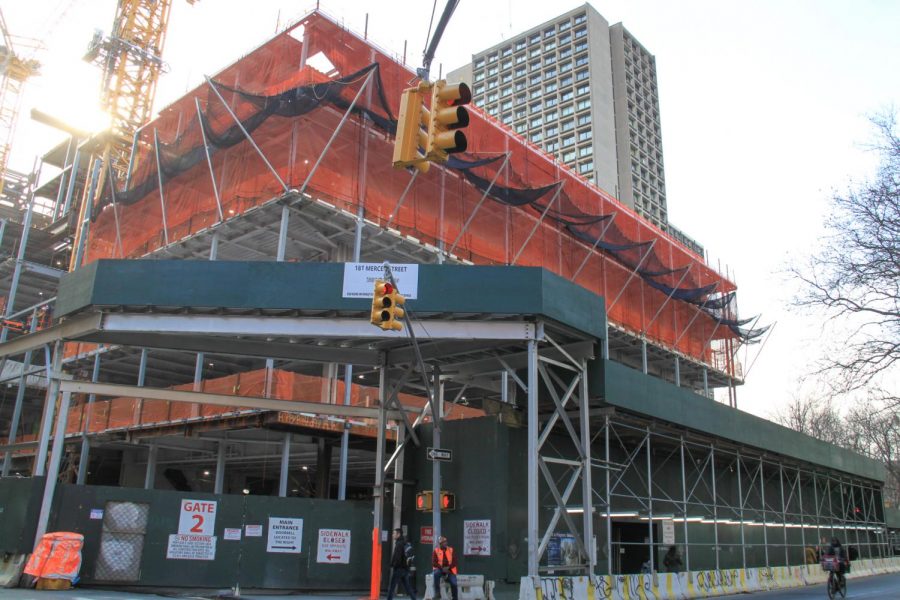Manhattan Community Board rejects controversial rezoning plan that critics say encourages further NYU expansion
Mayor Bill de Blasio’s administration says it is aiming to create affordable housing by rezoning parts of SoHo, NoHo and Chinatown. Critics say the proposed plan would do the opposite: encourage high-end retail and NYU expansion.
181 Mercer under construction in Lower Manhattan. Manhattan’s Community Board rejected a proposed rezoning plan that critics argued allow for further expansion of NYU. (Staff Photo by Alexandra Chan)
August 16, 2021
In a 37-1 vote, Manhattan’s Community Board 2 passed an 11-page resolution rejecting the SoHo/NoHo Neighborhood Plan presented by Mayor Bill de Blasio and the Department of City Planning on July 26. The plan, which sought to establish a new special district to modernize the area’s zoning and expand housing opportunities for New Yorkers, combines parts of the SoHo and NoHo neighborhoods into which NYU’s Washington Square campus extends.
“The proposed SoHo, NoHo and Chinatown rezoning fails to achieve affordable housing goals and instead incentivizes office, dormitory and large retail development and will displace existing rent-protected and low-income residents,” the resolution said.
The vote on the resolution — which was only the first step toward the plan’s final implementation — could influence future decisions about the rezoning. It is now up to Manhattan Borough President Gale Brewer to make an advisory recommendation, followed by a vote from the City Planning Commission to pass or reject the rezoning plan.
Brewer, who was present at the meeting, said that she is undecided on the rezoning and plans to hold a public hearing before her recommendation is due at the end of August. New York City Council member Margaret Chin, whose district includes the neighborhoods being considered for rezoning, did not immediately respond to a request for comment.
During the meeting, opponents of the plan — including members of neighborhood interest groups such as Village Preservation, a non-profit organization dedicated to preserving the architectural heritage and cultural history of Greenwich Village, East Village and NoHo — argued that the rezoning would erode the neighborhoods’ historic characters in favor of new retail and commercial-use buildings and, in doing so, make housing less affordable.
The rezoning would encourage NYU’s expansion into the neighborhoods south and east of Washington Square Park.
“The plan included one huge new terrible element — it would allow NYU to build and locate in these neighborhoods,” Village Preservation wrote in a campaign update on its website. “NYU has been trying to get into NoHo and SoHo for years, but current zoning prohibits it. The City’s plan would swing the doors wide open to the university, not only damaging the character of these neighborhoods but also giving developers one more way to avoid the affordable-housing requirements that are the supposed rationale for this plan.”
However, NYU says that the university’s footprint is not to blame for the negative effects of development contended by opponents of the rezoning plan.
“NYU has not been a main driver of the rezoning,” university spokesperson Shonna Keogan wrote in a statement to WSN. “But it is true that we do own and rent several properties in the area — all of which are historic buildings whose character we value and endeavor to preserve. We also believe that judicious use of space in NoHo/SoHo for academic purposes would effectively add to the character and vitality of these neighborhoods.”
In the resolution, the board also highlighted what it saw as a lack of outreach to Chinatown residents who would be affected by the rezoning. Public hearings on the plan have not always provided translations into dialects spoken by residents.
“The city has failed to reach out to the many residents who will be displaced and have been left in the dark by the mayor and DCP,” the resolution said. “The city continues to marginalize the residents of Chinatown by utterly failing to directly outreach to residents of Chinatown even though 43% of the new housing development is projected in Chinatown.”
Prior to the recent board meeting, the Manhattan Community Board 2 held a land use committee meeting on Zoom on April 19 and an in-person public hearing on July 8. During the April meeting, Andrew Berman — the executive director of Greenwich Village Society for Historic Preservation, who has spearheaded the campaign against the plan — said that the city’s plan would lead to a decrease in net affordable housing.
As an alternative, Berman promoted the Community Alternative Zoning Plan, created and endorsed by community groups including the Broadway Residents Coalition, NoHo Neighborhood Association, SoHo Alliance and the SoHo Design District in December 2020 — all of whom are represented in the city’s 18-member SoHo/NoHo Plan advisory board.
“What we don’t need are these massive giveaways to developers and zoning that’s really geared towards creating luxury condos, high-end commercial, office and boutique hotels, NYU dorm expansion [and] big-box chain stores,” Berman said. “This plan is a farce. I’m so glad the community board is rejecting it, and we need to make sure that our borough president and our city councilmembers do the same.”
Opponents of the plan also argue that downscaling of the city’s Joint Living-Work Quarters for Artists program would drastically reduce the amount of housing accessible and affordable to artists, who have contributed to the neighborhood’s prominence as an epicenter of culture. The JLWQA was first designated in the 1980s to protect New York City artists who live and work in rented spaces, and is currently the only as-of-right means of residing in those neighborhoods. Under the proposed plan, JLWQA units could be converted to residential units with the City Planning Commission’s certification and a contribution to an arts fund at $100 per square foot.
Leigh Behnke — an NYU alumna, co-founder of the Broadway Residents Coalition and artist who has lived and worked in the neighborhood since 1984 — expressed her concerns about the reduction of JLWQA housing at the July hearing.
“My only window faces the street … [in] this really noisy retail corridor,” Behnke said. “The expansion of this impactful use is misguided and will make mixed-usage a joke for the residential tenants.”
Mark Dicus, the executive director of the SoHo Broadway Initiative, said the rezoning proposal needs to elaborate on plans for supporting the arts and culture scene in SoHo.
“The current proposal lacks a defined program for the fund,” Dicus told WSN. “We think that the current proposed $100 per square foot is too burdensome on residents … Any plan for arts and culture should create affordable opportunities for artists to make art, as well as opportunities to celebrate art that is funded by a diverse and flexible set of funding streams.”
Some attendees at the July hearing, however, voiced their support of the plan and argued that it would be beneficial for the neighborhoods.
“This city in the last 10 years has done an incredible job of creating new jobs for people, but it actually has not built nearly enough housing to cover all the new jobs,” Ankur Dalal, a New York City resident of 15 years who attended the meeting, said. “I think this rezoning offers an opportunity to build 3,200 new homes, including 900 new affordable homes, in a neighborhood that, as the city planning department has pointed out, actually has no income-restricted affordable housing today.”
NYU Urban Design student Austin Celestin spoke to the board about what he learned from a study published by the Manhattan Institute in 2020. He highlighted Mandatory Inclusionary Housing, a zoning tool requiring a certain percentage of affordable units in residential developments. Meeting those requirements would be more effective and financially feasible in higher market areas including SoHo and NoHo, than in lower market areas where it has previously been used.
“I do believe that [the Department of City Planning] could add a little more to increase the proportion of affordable housing that is required,” Celestin told WSN. “But even if they didn’t, and just stuck with the 900 affordable housing units in the whole plan, that would still be substantially better than anything else that’s been put on the table.”
Contact Aneesh Kumar at [email protected]




























































































































































